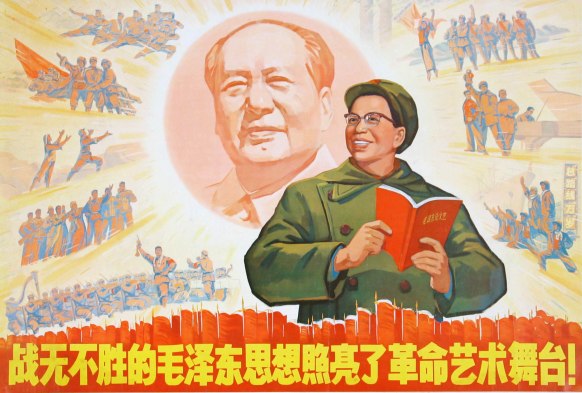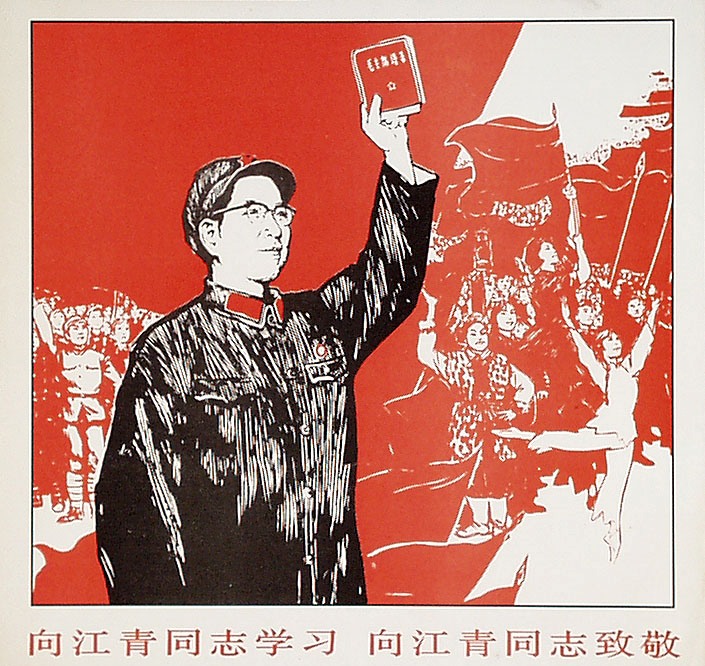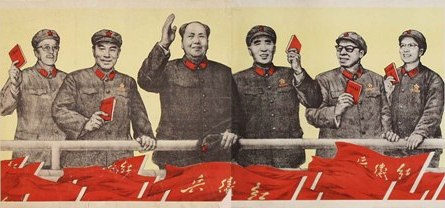Sharing Power with the Chairman
By: Stefan R. Landsberger

Stefan R. Landsberger
Jiang Qing dominated the Chinese arts. In particular she attempted to reform the Beijing Opera. She developed a new form of art called "model works" (
yangbanxi) that depicted the world in simple, binary terms: all the good guys were farmers, workers and revolutionary soldiers who sang and danced around on the stage. All the bad guys were landlords and anti-revolutionaries who wore dark make-up and moped around on the outskirts of the stage. The fact that Mao is beaming down on her, as well as that Mao's Red book is in her hands, is no coincidence: her power was largely vested in her relationship to the Chairman.
View Larger >
Stefan R. Landsberger
With time, Jiang began playing an increasingly active political role in the movement. She took part in most important Party and government activities. She was supported by a radical coterie, dubbed, by Mao himself, the Gang of Four. Although a prominent member of the Central Cultural Revolution Group and a major player in Chinese politics from 1966 to 1976, she essentially remained on the sidelines. Her posture and choice of clothing in this poster is reminiscent of Mao, whom she imitated.
View Larger >
Stefan R. Landsberger
Jiang Qing is depicted as a healthy, smiling young man on the extreme right of this poster that features the main leaders of the Cultural Revolution. She stands next to Chen Boda, Mao's long-standing private secretary (second from right). The other leaders on this poster are, from left, Kang Sheng, head of the Secret Service (and allegedly Jiang's erstwhile lover); Zhou Enlai, prime minister and secretary of state; Mao; Lin Biao, secretary of defense and the mastermind behind Mao worship; Chen Boda; and finally Jiang.
View Larger >
Stefan R. Landsberger
Made in 1976 and published a year later, this poster can be conceived as an allegorical depiction of Jiang's fall from grace. Entitled "Monkey defeats the White Bone Demon three times," it shows Monkey (which personifies the Chinese people) defeating the White Bone Demon, a devil of the first order, believed to be Jiang Qing. Seen from the chronology, such a reading of the image is quite appropriate. However, veteran poster designers such as Ha Qiongwen and Qian Daxin believe that it is "pure coincidence".
View Larger >After the People's Republic was founded in China in 1949, the communist government used
poster campaigns to promote women's liberation. Most of these campaigns focused on women's role in the economic development of the fledgling Republic. Posters served the explicit educational function of showing women new approaches and techniques for doing various tasks they were now expected to perform. However, persons in positions of real authority continued to be men.
The most powerful of those men was, of course, Mao Zedong. He regularly appeared in visual propaganda. Women, on the other hand, seldom occupied leadership positions at the highest levels and were seldom represented in posters as political leaders. Jiang Qing, Chairman Mao's wife, was the most notorious of those rare women who were recognized, and imortalized, as political leaders through illustrations.
Jiang Qing was born in Zhucheng, Shandong Province, in 1914. Assuming the stage name Lan Ping, she became a moderately successful actress in the 1930s in Shanghai. During that time, a close friend introduced her to Mao Zedong. Although Mao was married, he fell in love with the actress and filed for divorce, marrying her in 1939. The Party leadership strongly objected to the divorce and the new marriage, which was Mao's third. Eventually, the Party was appeased on the condition that Jiang Qing limited herself to the role of a housewife and refrained from playing any role in politics (including making public appearances with him) for the duration of twenty years.
Jiang Qing served as Mao's personal secretary in the 1940s and was head of the Film Section of the CCP Propaganda Department in the 1950s. In the early 1960s, she made a bid for power during the Cultural Revolution (1966-1976), which resulted in widespread chaos within the communist party.
In 1966 she was appointed deputy director of the Central Cultural Revolution Group and claimed real power over Chinese politics for the first time. She became one of the masterminds of the Cultural Revolution, and along with three others, held absolute control over all of the Republic's institutions.
Becoming a powerful figure in her own right, she appeared, for the first time, in political posters. In these posters, she appeared austere and very masculine: her public persona was mainly inspired by the dominant military and proletarian aesthetic. Depicted alongside men, an undiscerning eye wouldn't be able to single her out. She wore her hair short, further hidden under a cap. She looked much like the Chairman.
When Mao died in 1976, Jiang lost support and justification for her political activities. When she was arrested and sentenced to death, many, if not most, Chinese citizens rejoiced. In January of 1983, her sentence was commuted to life imprisonment. Suffering from throat cancer, she was released on bail for medical treatment in May of 1991. Ten days after her release, she allegedly committed suicide.





